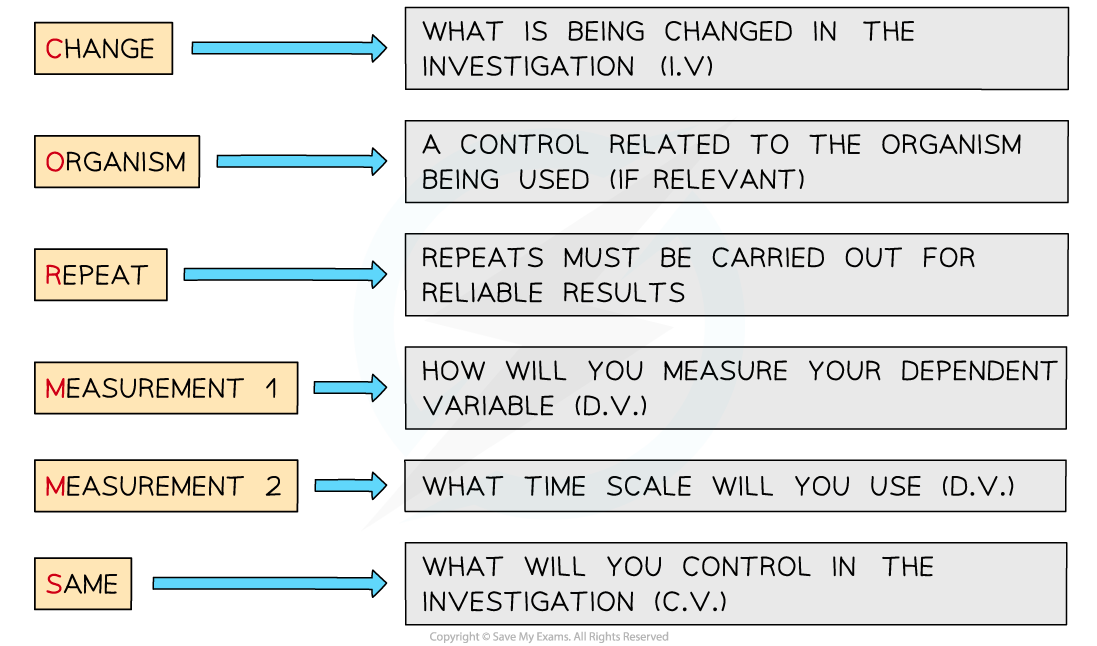Practical: Investigating Temperature & Enzyme Activity (Edexcel IGCSE Biology: Double Science)
Revision Note

Author
LáraExpertise
Biology Lead
Practical: Enzymes & Temperature
- Amylase is an enzyme that digests starch (a polysaccharide of glucose) into maltose (a disaccharide of glucose)
- The effect of temperature on the activity of amylase can be investigated
Apparatus
- Spotting tile
- Measuring cylinder
- Test tube
- Syringe
- Pipette
- Stopwatch
- Water
- Thermometer
- Water bath
- Iodine
- Starch solution
- Amylase solution
Method
- Add 5cm3 starch solution to a test tube and heat to a set temperature using beaker of water with a Bunsen burner
- Add a drop of Iodine to each of the wells of a spotting tile
- Use a syringe to add 2cm3 amylase to the starch solution and mix well
- Every minute, transfer a droplet of solution to a new well of iodine solution (which should turn blue-black)
- Repeat this transfer process until the iodine solution stops turning blue-black (this means the amylase has broken down all the starch)
- Record the time taken for the reaction to be completed
- Repeat the investigation for a range of temperatures (from 20°C to 60°C)

Investigating the effect of temperature on enzyme activity
Results and Analysis
- Amylase is an enzyme which breaks down starch
- The quicker the reaction is completed, the faster the enzyme is working
- This investigation shows:
- At the optimum temperature, the iodine stopped turning blue-black the fastest
- This is because the enzyme is working at its fastest rate and has digested all the starch
- At colder temperatures (below optimum), the iodine took a longer time to stop turning blue-black
- This is because the amylase enzyme is working slowly due to low kinetic energy and few collisions between the amylase and the starch
- At hotter temperatures (above optimum) the iodine turned blue-black throughout the whole investigation
- This is because the amylase enzyme has become denatured and so can no longer bind with the starch or break it down
- At the optimum temperature, the iodine stopped turning blue-black the fastest
Limitations
- Note that there are several different ways in which the temperature could be controlled. The method described above is not very precise, an improvement would be to use water baths kept at each temperature
- The starch and amylase solutions that need to be used should be placed in a water bath and allowed to reach the temperature (using a thermometer to check) before being used
- A colorimeter can be used to measure the progress of the reaction more accurately
- A solution containing starch will be darker than a solution containing glucose (as a result of the colour change of iodine)
- The absorbance or transmission of light through the coloured solution can be measured using a colorimeter
Applying CORMS to practical work
- When working with practical investigations, remember to consider your CORMS evaluation

CORMS evaluation
- In this investigation, your evaluation should look something like this:
- C - We are changing the temperature in each repeat
- O - This is not relevant to this investigation as we aren't using an organism
- R - We will repeat the investigation several times to make sure our results are reliable
- M1 - We will measure the time taken
- M2 - for the iodine to stop turning black
- S - We will control the concentration and volume of starch solution, iodine and amylase used in the investigation
Exam Tip
Describing and explaining experimental results for enzyme experiments is a common type of exam question so make sure you understand what is happening and can relate this to changes in the active site of the enzyme when it has denatured, or if it is a low temperature, relate it to the amount of kinetic energy the molecules have.

You've read 0 of your 0 free revision notes
Get unlimited access
to absolutely everything:
- Downloadable PDFs
- Unlimited Revision Notes
- Topic Questions
- Past Papers
- Model Answers
- Videos (Maths and Science)
Did this page help you?